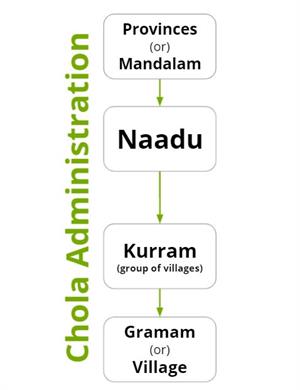
PUMPA - SMART LEARNING
எங்கள் ஆசிரியர்களுடன் 1-ஆன்-1 ஆலோசனை நேரத்தைப் பெறுங்கள். டாப்பர் ஆவதற்கு நாங்கள் பயிற்சி அளிப்போம்
Book Free DemoAdministration
The king was in charge of the central government. Thus, the king wielded immense influence as the state's leader. The king's instructions were written on palm leaves or engraved on the temple walls by his officials. The Yuvarajas were appointed to the provinces as governors primarily to provide administrative training.
The kingship was hereditary in nature. The king chose his eldest son as the clear successor. He was known as Yuvaraja.

The empire, for administrative convenience, was divided into provinces or mandalam. Each mandalam was sub-divided into naadu. Within each naadu, there were many kurram (groups of villages). The lowest unit was the gramam (village).
Local Governance
The local administration was supported by several organisations, including Urar, Sabhaiyar, Nagarattar, and Nattar. Agricultural growth spawned a slew of peasant settlements throughout the countryside. Ur was the name given to them. The Urar, who were landowners, served as the spokesmen. Sabhaiyar also performed administrative, financial, and judicial functions in Brahman villages.
Nagarattar was in charge of trade settlements. Nagaram did have skilled artisans such as masons, blacksmiths, goldsmiths, weavers, and potters. Nattar functioned as an assembly of Nadu and decided all the disputes and issues pertaining to Nadu.
Various committees served in the Ur, Sabha, Nagaram, and Nadu assemblies. Irrigation, highways, temples, parks, revenuecollection, and religiousfestivals were all handled by the committees.